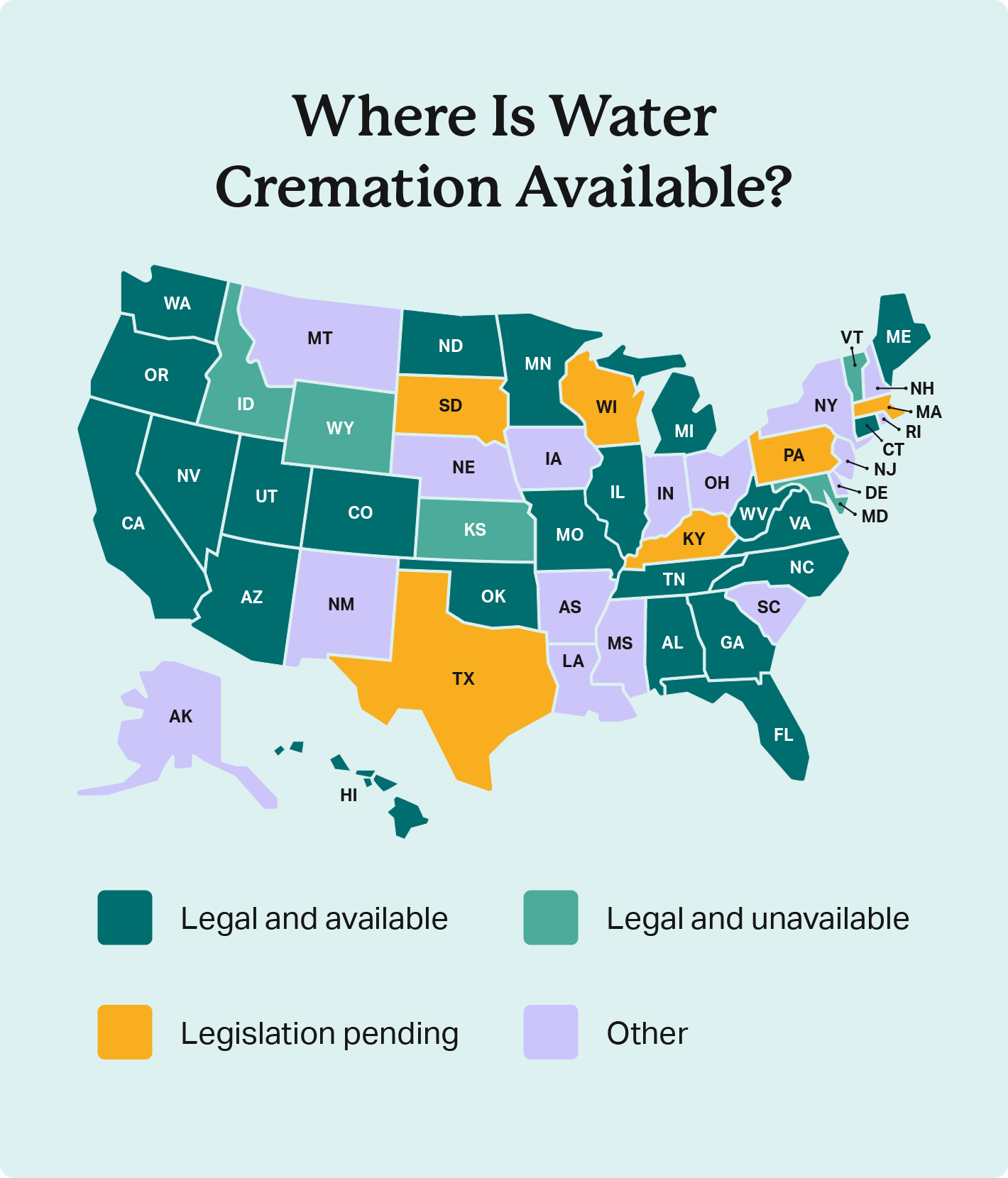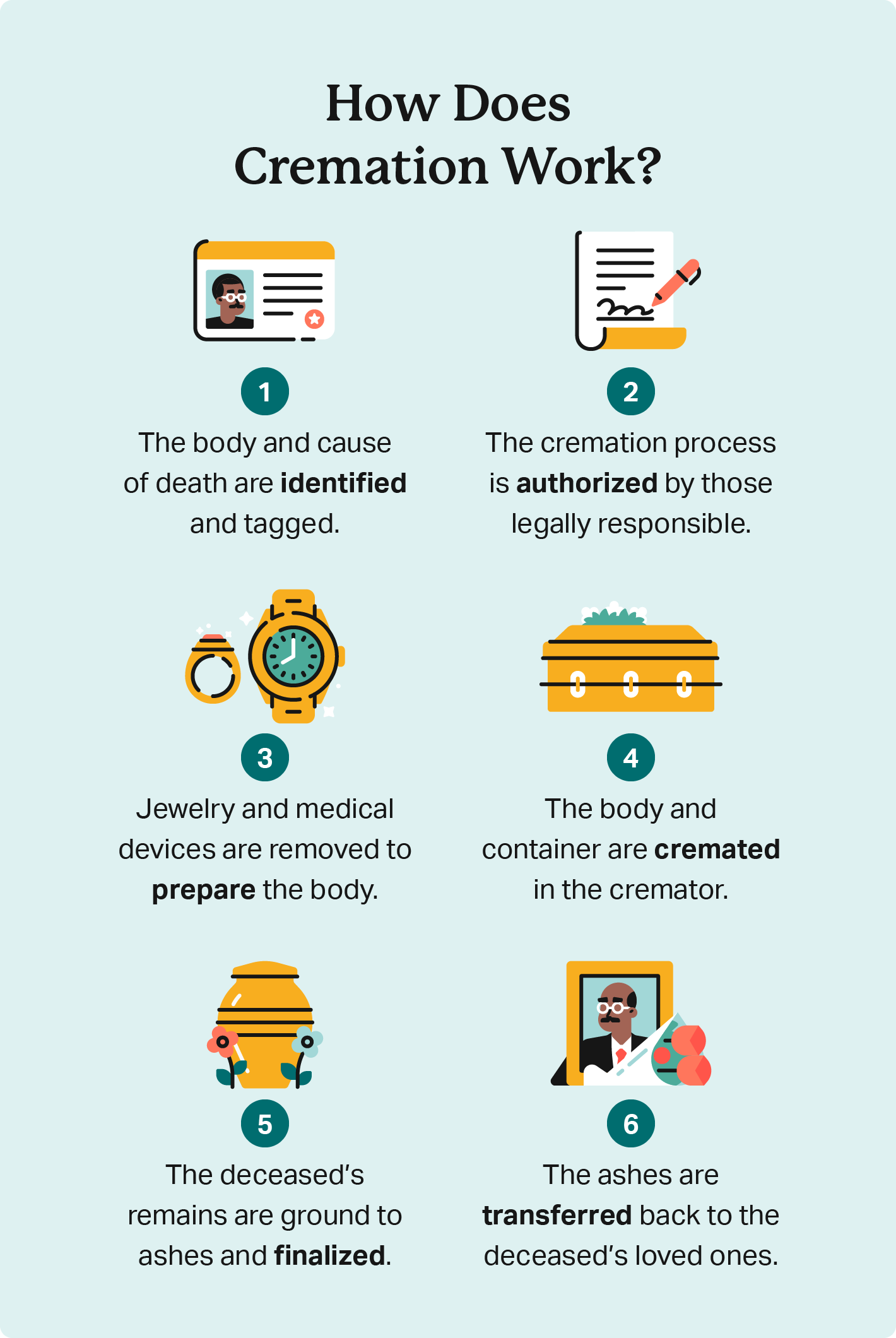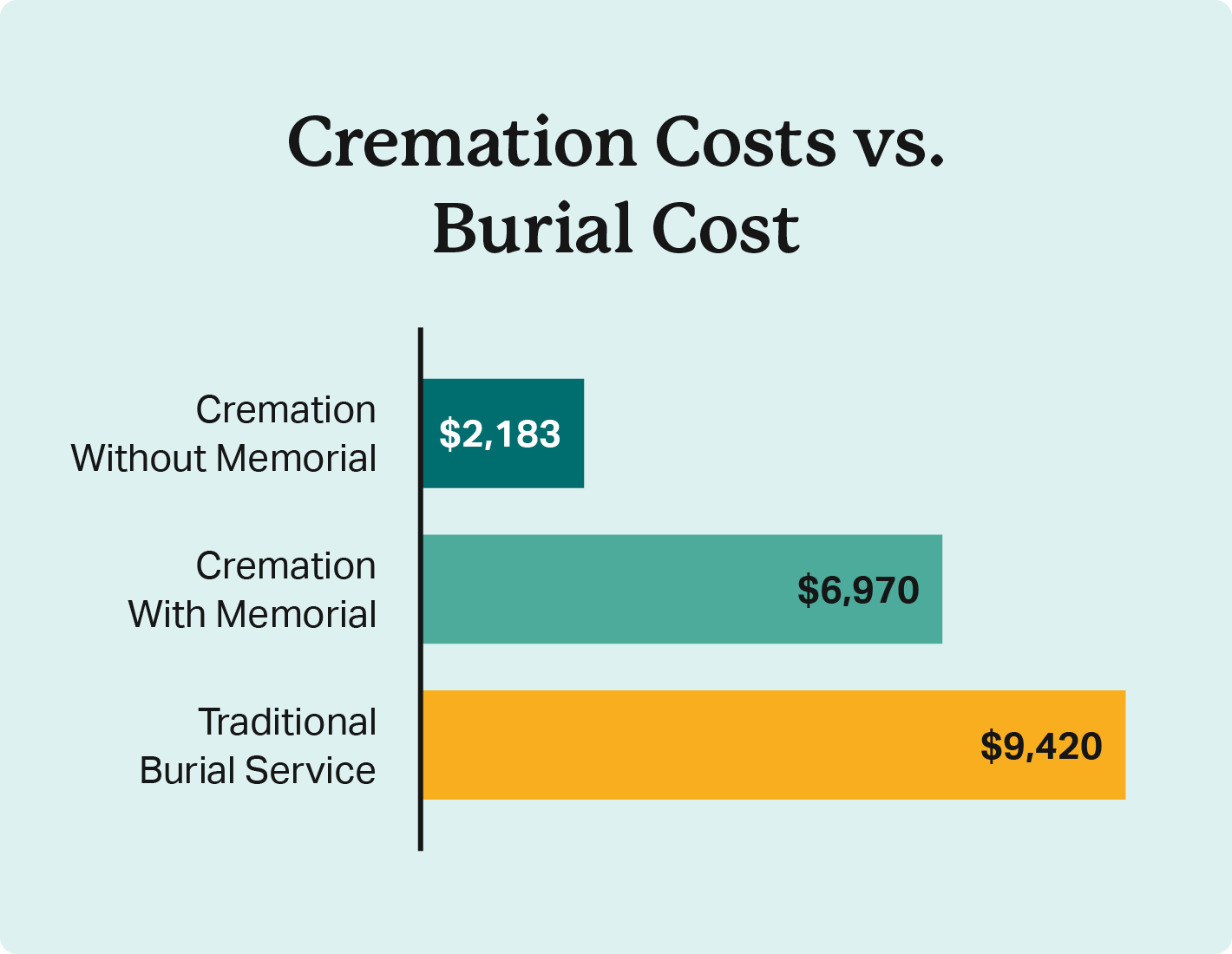The cremation process has existed for more than 20,000 years, but it can still be an uncomfortable post-death topic for many people. With plenty of funeral and memorial decisions to make when a loved one passes away, it can be difficult to consider nontraditional funeral options when the processes are unfamiliar.
Cremation allows loved ones to rethink funeral factors like memorial flexibility, personalization, and environmental consequences while respectfully honoring the life of the deceased.
But how does cremation work? Figuring out the cremation process and calculating the potential funeral costs of cremation services can help you make an informed decision about the end-of-life plans for you or a loved one.
What Is Cremation?
Cremation refers to the process of breaking down human remains into bone fragments through mechanical, thermal, or other methods. This procedure also includes the act of crushing remaining bone fragments into pieces that are usually less than an eighth of an inch thick and long.
There are different types of cremation — including direct or flame cremation and water cremation — but direct cremation is the most common form throughout the United States.
| Direct Cremation vs. Water Cremation | ||
|---|---|---|
| Direct Cremation | Water Cremation | |
| Process | Uses flames and extremely high heat | Uses chemicals, liquid, and low heat |
| Temperature | Up to 1,800 degrees Fahrenheit | 199 to 302 degrees Fahrenheit |
| Result | Ashes placed in an urn | Up to ⅓ more ashes placed in an urn |
| Preparation | Removal of certain medical devices and implants | State laws dictate medical device and implant removal |
| Time | 1 to 4 hours | 3 to 18 hours |
| Cost | $2,183 on average with no memorial service | $2,000+ on average with no memorial service |
| Availability | All 50 states | Select states and providers |
| Environmental Impact | Potentially worse | Potentially better |
Direct cremation
Direct cremation is the most traditional form of cremation. The process occurs inside a metal chamber called a cremator, cremation unit, or retort that is lined with special materials to help retain heat and increase efficiency.
Water cremation
Water cremation — also known as water-based cremation, aquamation, or flameless cremation — uses chemicals, liquids, and low heat to carry out the cremation process. Scientifically, this is referred to as alkaline hydrolysis.
Because the solution leftover from the procedure is sterile, it can be recycled within the wastewater treatment system. Sometimes referred to as bio cremation or green cremation, water cremation is a more environmentally friendly option than traditional cremation, but it is only available in select states.
The 6-Step Cremation Process
The cremation process begins at death and ends once the ashes of the remains are returned safely to the deceased’s loved ones. To ensure the process is successful and respectful, morticians follow an important six-step system for direct cremations.
Step 1: Identification
Before authorization for cremation is granted, medical professionals and caretakers identify the deceased and their cause of death. During this process, the remains are tagged with fire-resistant identification tags. These tags help verify the identity of the ashes even after the cremation process is completed.
Step 2: Authorization
Those verifying and agreeing to the cremation of the remains are asked to sign authorization documents to confirm to the crematory that cremation is the correct next step. These documents also contain information about what container the morticians should use and who is responsible for picking up the ashes.
Step 3: Preparation
Before cremation, the remains of the deceased must be prepared. At this stage, the body is stripped of jewelry and mechanical or battery-operated medical devices. Remains are not embalmed at this stage unless specifically requested. Finally, the body is placed in a combustible container, which will be cremated with the remains.
Step 4: Cremation
The body and container must be moved into the cremator for the process to proceed. After the remains are exposed to extreme temperatures, the ashes require a cooling-off period before they can be handled, packaged, and transferred back to the deceased’s loved ones.
Step 5: Finalization
The finalization process consists of removing any metal that may remain in the ashes before grinding the bone remnants down using a special machine. Metal items like pins and screws may be present after cremation and will be removed before the ashes are transferred.
Step 6: Transfer
During the final stage of the cremation process, the ashes are transferred to an urn or secondary container. They are then returned to the individual responsible for collecting the ashes.
How Long Does Cremation Take?
Direct cremation can take between one and four hours and water cremation can take up to 18 hours. There are a variety of factors that can affect how long cremation takes, including the:
- Size of the body
- Weight of the body
- Type of container holding the body
- Efficiency and age of the equipment
Usually, cremation is the most time-efficient process compared to traditional burial methods.
The Body During The Cremation Process
During the cremation process, human remains are destroyed. All that will remain at the end of the process is bone fragments and any internal metal that was left behind during the preparation stage, including:
- Artificial hips, knees, and shoulders
- Medical pins
- Titanium spinal rods
- Wires
- Surgical clips
- Medical staples
Before the body can enter the cremator, both the remains and the loved ones must be prepared for the cremation process.
How is the body prepared for cremation?
To prepare a body for cremation, the mortician will remove items that can cause adverse reactions in the cremator. While clothing usually remains on the body, jewelry and other worn items are removed and returned to the deceased’s loved ones. Then, morticians remove any external medical devices that are mechanical or battery-operated.
The crematory operator will then place the body onto a cart or hydraulic lift table, record its weight, register the name of the funeral director, and note the start and end times of the cremation process. Finally, the body is placed in a combustible container that is then cremated with the body.
What can be cremated with a body?
Items that could cause a reaction or problems during the cremation process must be removed and cannot be cremated with the body. With direct cremations, these items cannot be included:
- Batteries
- Pacemakers
- Implantable cardioverter defibrillators (ICDs)
- Pain pumps
- Spinal cord stimulators
- Cancer seeds
- Prosthetic limbs
- Silicone implants
These items could cause damage to the cremator or the refractory bricks. However, items like clothing and other combustible, sentimental items can sometimes be cremated with the deceased — this is decided by each individual crematorium and caretaker.
Cremated ashes: What to expect
Due to the cremation process, ashes can have different final consistencies. Most cremated ashes are gritty with small pieces in them. Different morticians and processing equipment can produce finer or grainier remnants.
After the cremation and the cooling-down period, ashes are carefully packaged into a bag along with the fire-resistant identification tag. These are then placed into a utility urn or decorative urn, depending on the decisions of the deceased’s loved ones.
Cremation Costs
The national average cost of cremation is $6,970, which includes a viewing and a funeral service. However, cremation costs vary by provider and region, and they can fluctuate based on memorials, viewings, body weight, witnessing, and more.
For direct cremations, the cost includes:
- Transporting the body to the funeral home
- Collecting the necessary information and completing the required paperwork to authorize the cremation
- Keeping the body in cold storage between death and cremation
- Filing the death certificate
- Performing the cremation
- Placing the ashes in a temporary urn
Other additions — including expedited service, obituaries, and memorial programs — can increase the cost of cremation. While cremation costs can be significant, you can purchase cremation insurance to pay for a service and other final expenses.
Frequently Asked Questions
A crematorium is a facility where the cremation process happens. This facility houses the cremator and can be home to a chapel or memorial spaces as well.
An urn is a container that holds the finalized ashes of cremated remains. These containers frequently resemble tall, rounded vases with secure lids. Modern urns come in a variety of materials and shapes for different purposes, including ceramic urns, wood urns, scattering urns, and even tree pod urns.
No, only one body is cremated at a time. Before the cremation process begins, the cremator must be emptied of any previous ashes or remains. This ensures that the deceased’s ashes are left uncontaminated.
Before a body is cremated, mechanical or battery-operated medical devices, and other items like jewelry are removed from the body. These items could cause dangerous reactions to occur during cremation, so they must be removed to keep the space safe for the mortician.
When a body is cremated, the coffin is cremated as well. Most cremation coffins are made of inexpensive materials that are combustible such as woodgrain laminate, pine, or plywood.
The crematory issues the deceased a metal tag or medallion that is typically placed inside the coffin with the body or outside the retort during the cremation process to help keep track of each identity. It has a unique identification number for each person and it includes the name of the crematory. The metal tag does not burn during the cremation process, so it can help identify remains both before and after cremation.
Consider Your End-Of-Life Plans
Whether you are planning your own funeral or the memorial service of a loved one, the decisions can be overwhelming. Understanding your options before needing to make a decision can help ease some of the anxiety you may feel in the moment.
If you’re considering the cremation process, learning how the process works and investing in final expense life insurance is a great way to prepare your end-of-life plans before they become necessary.
Sources:
- US Funerals Online
- Nationally licensed life insurance agent with over 15 years of experience
- Personal annual production that puts him in the top .001% out of all life insurance agents in the nation.
Anthony Martin is a nationally licensed insurance expert with over 15 years of experience and has personally served over 10,000 clients with their life insurance needs. He frequently authors entrepreneurial and life insurance content for Forbes, Inc.com, Newsweek, Kiplinger, and Entreprenuer.com. Anthony has been consulted as an expert life insurance source for dozens of high-profile websites such as Forbes, Bankrate, Reuters, Fox Business, CNBC, Investopedia, Insurance.com, Yahoo Finance, and many more.
- Nationally licensed life insurance agent with over 19 years of experience
- Best selling Amazon author.
Jeff Root is a nationally licensed life insurance expert with over 19 years of experience. He has personally helped over 3000 clients with their life insurance needs. Jeff is a best-selling Amazon author and the managing partner of a highly successful insurance brokerage that manages over 2,500 licensed insurance agents across the USA. He has been a featured life insurance source for prestigious websites such as Forbes, Bloomberg, MarketWatch, Nerdwallet, and many more.
- Nationally licensed life insurance agent with over 14 years of experience
- Best selling Amazon author of five insurance sales books.
David Duford is a nationally licensed insurance expert with over 14 years of experience. He has personally helped more than 15,000 clients buy life insurance. David has been featured as an expert source for highly authoritative publications such as A.M. Best and Insurancenewsnet. He also runs one of the largest Youtube channels to help aspiring insurance agents serve their clients better.
- Nationally licensed life insurance agent with over 19 years of experience
- Best selling Amazon author.
Jeff Root is a nationally licensed life insurance expert with over 19 years of experience. He has personally helped over 3000 clients with their life insurance needs. Jeff is a best-selling Amazon author and the managing partner of a highly successful insurance brokerage that manages over 2,500 licensed insurance agents across the USA. He has been a featured life insurance source for prestigious websites such as Forbes, Bloomberg, MarketWatch, Nerdwallet, and many more.
- Nationally licensed life insurance agent with over 14 years of experience
- Best selling Amazon author of five insurance sales books.
David Duford is a nationally licensed insurance expert with over 14 years of experience. He has personally helped more than 15,000 clients buy life insurance. David has been featured as an expert source for highly authoritative publications such as A.M. Best and Insurancenewsnet. He also runs one of the largest Youtube channels to help aspiring insurance agents serve their clients better.
Choice Mutual often cites third-party websites to provide context and verification for specific claims made in our work. We only link to authoritative websites that provide accurate information. You can learn more about our editorial standards, which guide our mission of delivering factual and impartial content.
-
more than 20,000 years. https://www.honanfh.com/history-of-cremation
-
increase efficiency. https://www.cremationassociation.org/blogpost/776820/303153/Refractory-Rules-Five-Tips-to-Maximize-Cremator-Efficiency
-
alkaline hydrolysis. https://www.cremationassociation.org/page/alkalinehydrolysis











